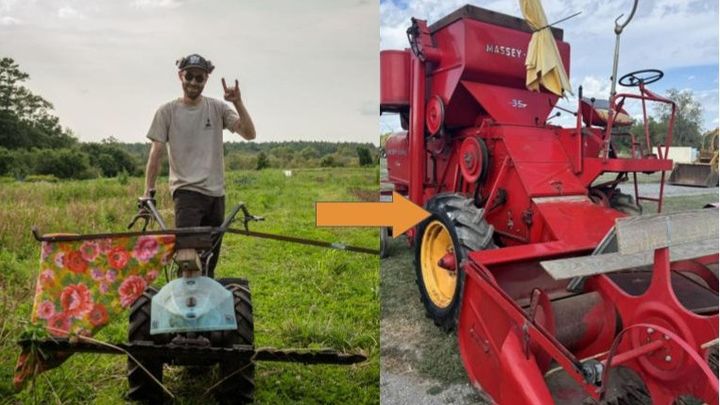
Small Combine Fundraiser
Donation protected
Here and There Grain Project is raising $6,500 to purchase a small, self-propelled combine and an equipment trailer. Since 2021, Andrew Dixon has partnered with two local farms to bring six acres of grains to market. Technical assistance has been the focus of this small agribusiness; borrowing, repairing, and operating equipment to assist farmers incorporating grains into their vegetable growing rotations. The purchase of a small combine and trailer will enable the Here and There Grain Project to assist more farmers in their efforts to diversify and rest their fields by providing a reliable harvesting service for cover crops. By donating to this fundraiser you're contributing to a small step in a larger shift towards small "r" regenerative agriculture in coastal Massachusetts and the Merrimack Valley.
As local and regional grain economies are rebuilt, the primary bottleneck has become evident: the small combine is missing. Read on to learn more.
There are many reasons why small grains like wheat and rye are the last player invited into the local food movement in the United States, but up and down the East Coast, the revival is underway! Flour is largely thought of as an anonymous bagged ingredient on the shelves at the grocery store, but it is time that we start thinking of baking as an agricultural act. Over 80 percent of the human diet is provided by plants, yet only three cereal crops–rice, maize and wheat–provide 60 percent of energy intake globally (UNDP, 2021).
The combine is a marvel of efficiency. Used in grain harvests, it performs the cutting, threshing, and winnowing processes all at once. In the 1970s, farm equipment manufacturers and distributors in the United States abandoned the production and sale of small combines in favor of larger, more expensive machines that serve the industrial-scale, commodity producing farms. This has created a significant hurdle for organic, small- and medium-scale growers as they look to incorporate grains on their farmlands. The passionate grower is left to either refurbish or import their small combine. In Massachusetts, there are 4,890 small farms (growing on less than 49 acres) per the USDA census of agriculture (2022), and New Hampshire stats tell a similar story. There could be far more local organic grain production if small combines were more readily available.
Machinery hurdles are not the only ones. Organic grain growers face challenges that conventional growers manage using applications of chemicals. For the organic grower, there is a balance to be struck between yield and weed suppression. Given the opportunity, skilled growers will dial this in, selecting their grain varieties and strategies for field rotations, boosting their investment in the health of their soil and adding one more marketable product to offer their communities in a time of year when vegetable production is at a minimum. Learning curves and infrastructure shortcomings are surmountable, but they'll need a harvester to get started.
The model that the Here and There Grain Project is pursuing is an adaptation of what is known as "custom combining." West of the Mississippi, combines are hauled Northward from Texas to Saskatchewan following the dry-down dates for harvests of grains and legumes. To fit peri-urban New England, we’ve got some ideas, but suffice it to say that this would be the only harvesting service of its kind and we’re looking for your help.
To be clear, this is not just about delicious bread that is more flavorful and nutritious—though that’s important too! This is also about adapting to changing climates, social solidarity, seed sovereignty, and holding up our end of a reciprocal relationship with farmlands, giving back here and there. As vital as it is to source organic fruits and vegetables from our local farmers, it is also essential that we move towards a place-based way of thinking about our grains. This is done by supporting the farmers, millers, bakers, maltsters, brewers, and distillers working to restore non-commodity regional grain economies. For farmers in New England, it starts by increasing access to shared-use equipment; refurbishing an old combine, putting it on a trailer, and providing a reliable harvesting service gives more farmers a chance to grow cover crops like barley, wheat, and rye for human consumption, unlocking one more gate for farmers transitioning to low-till practices.
The impact of your support in this fundraising campaign will be felt by at least three small farms in the next two years as Here and There Grain Project increases its reach by going mobile, increasing the local flour acreage in coastal Massachusetts and the Merrimack Valley. The purchase of the Massey Harris 35 combine will support Rusted Rooster Farm, a pioneering organic grain grower in Maine, as they make their next step. This campaign gives you a direct relationship to the grains being grown locally with new stories and unique terroir. You’ll also be supporting a project that is intentional in its adoption of technology, deepens the conversation about what tech is beneficial for our ecology, feeds people, nourishes Mother Earth, and demonstrates opportunity for mechanically-inclined young people who are concerned with our food system. This is a small step towards food sovereignty in our region, but it’s a collection of small steps that lead to broader change.
For more nitty gritty details, including historical precedence and practical considerations, check out the Here and There Grain Project website (recently updated, still a work in progress), hereandtheregrain.com. Thanks for considering making a contribution.
From your grainiac pals,
Let it grow!
 Organizer
Organizer
Andrew Dixon
Organizer
Essex, MA